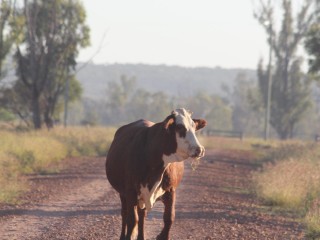 If you’d been told at the start of this year that 2011 would see the Australian dollar average US $1.03, a devastating earthquake and recession in Japan, the calamitous closure of Australia’s biggest live export market and a return to GFC-like economic jitters throughout the world, you could only have imagined how low cattle prices would be by December.
If you’d been told at the start of this year that 2011 would see the Australian dollar average US $1.03, a devastating earthquake and recession in Japan, the calamitous closure of Australia’s biggest live export market and a return to GFC-like economic jitters throughout the world, you could only have imagined how low cattle prices would be by December.
Yet here we are within two days of Christmas and young cattle prices are at record levels, and all other price categories also stand well above year ago levels.
What gives?
One reason for the strong run of prices lies with the impact of continued wet weather on supplies of saleable cattle this year.
Good rainfall in major production areas has kept restocker demand keen and has also slowed the flow of cattle to market, both by making physical movements to sale difficult and encouraging more producers to hold onto cattle for finishing through to slaughter weights.
However, Meat and Livestock Australia’s chief economist Tim McRae believes something more than wet weather in Australia is at play.
 “To have a year where we have had prices across all categories average higher year on year, it has got to be something more than just tight supply,” Mr McRae said.
“To have a year where we have had prices across all categories average higher year on year, it has got to be something more than just tight supply,” Mr McRae said.
“There is certainly a general increase in prices globally, so to me that means there is something more fundamentally going on globally for beef demand than just a good season in Australia underpinning prices.
“It has to be, and I think the evidence to that is our shipments to other markets, there are other markets that are now competing for product that 10 years ago had we seen a downturn to the US and Japan, we would have really felt that in the saleyards.”
Beef Central caught up with Mr McRae yesterday to discuss the early thoughts on where cattle markets are headed in 2012.
The overall picture is of a year in which supply starts to come back into balance and where international issues such as currency rates, greater US competition in Japan and Korea and unfolding economic turmoil in Europe dominate the demand outlook.
Biggest herd in 35 years
The official commodity forecaster ABARES last week predicted that Australian cattle numbers will surpass 30 million head next year, the highest level in 35 years.
The forecast is based on Australian Bureau of Statistics estimates which place the herd at 28.8 million head in 2011. That figure is drawn from the national agricultural census conducted across Australia earlier in the year.
MLA is confident that ABARES’ forecast is accurate, based on the integrity of ABS’s census data and the view that with another wet summer fuelling continued herd rebuilding across Australia, a further 4 percent increase in herd numbers for the next 12 months is more than feasible.
Shortage or not?
Given that market trends in 2011 have been dominated by cattle shortages, talk of Australia suddenly being on the verge of its largest herd in 35 years may seem difficult to comprehend.
But it also reflects the long turnaround that it takes in the cattle industry for good seasons to convert into higher branding rates.
Mr McRae believes the general supply shortages experienced this year draw back to the very poor branding years experienced in 2008, 2009 and a large portion of 2010.
“You’re talking about over one million head not being on the ground from those bad years, so you multiply that through and that has been affecting numbers through 2010-2011 and probably into 2012,” he said.
“Certainly this year we would expect branding rates to be considerably higher which gives you more cattle coming into the system, but they don’t enter the slaughter system until late 2012.”
With a run of improved seasons over the past two years, and more cows in paddocks (reflected by lower cow slaughter rates in 2011), Mr McRae is confident the industry has now come through the low point of supply.
March/April key supply signpost
In line with that forecast, it would seem inevitable that 2012 will see an increase in the numbers of available slaughter cattle compared to 2011.
A decline in the volumes of cattle transacted this year supports the view that producers have taken advantage of the improved seasons to keep more cattle at home for finishing this year.
Drier periods tend to producer greater numbers of transactions as more cattle are turned off at earlier ages and sold to other buyers for finishing, such as in feedlots, before being consigned to slaughter.
However this year many breeders had held cattle to finish them and sell them straight through.
“I think a big influence is that when producers have grass, they like to sell finished stock,” Mr McRae said.
“And there’s a lot of areas with a lot of grass.”
March and April – the end of the northern wet season and the start of the autumn break in the south – is shaping as an important signpost to how supply trends will pan out in the traditional peak turnoff period of May/ June .
With a build-up of finished grassfed cattle occurring, the potential exists for larger numbers of slaughter cattle to suddenly come forward if and when hot dry conditions set in.
When will non-exported northern cattle show up?
April/May is shaping as the period in which the slaughter market is likely to see the first of the 100,000 or so northern cattle that missed export to Indonesia last June and July as a result of the Federal Government’s export ban.
It is believed most of those redirected cattle were moved south into western Queensland for finishing and will have had 10 to 11 months on grass by April/May.
“Many of them were probably already 30-40 kilograms ahead of where they would have been anyway, so I think that April May period will see the could see the front end of those cattle moving,” Mr McRae said.
Last week’s announcement of dramatically reduced Indonesian import quotas for 2012 could also result in an additional 200,000 plus northern cattle needing to find domestic buyers at some point, particularly if
import allocations are not raised as the year progresses and if significant new orders are not found from other live export markets.
Dollar drives demand outlook
Continued global economic jitters aside, the elephant in the demand room heading into 2012 – as it proved to be for most of 2011 – remains the performance of the Australian dollar.
Australian exporters have faced a tough year in Japan and Korea as a weaker greenback has given competing US exporters a significant price-advantage in the high value export markets for the first time.
That level of competition is only likely to intensify in 2012 as Japan lifts age restrictions on US imports from less than 20 months to under 30 months from April, and the recently signed KORUS free trade agreement further increases the price competitiveness of US beef exports into Korea.
Unfolding economic deterioration in Europe also overhangs the outlook for 2012.
While Australia does not expect large volumes to Europe, the potential for a downturn to affect other markets that Australia does rely upon will be the main issue.
“How it affects the (Australian) dollar is where it is going to have the quickest impact,” Mr McRae said.
The increasing diversification of Australia’s export markets and rising importance of markets such as Russia and the Middle East should help to cushion some of the impact of challenges in the major markets, Mr McRae said.
